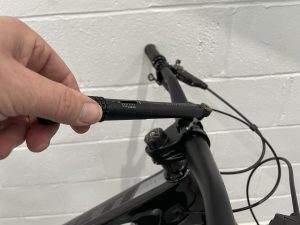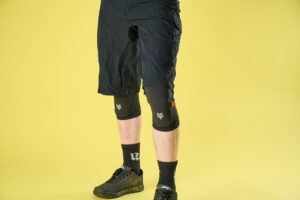Fox Float RP23 £299
 Sizes: 140×25.4, 150×31.75, 165×38.1, 190×50, 200×50, 200x57mm / 190 and 200 come with the large volume aircan / Adjustments: rebound, three ProPedal settings / Weight 246g
Sizes: 140×25.4, 150×31.75, 165×38.1, 190×50, 200×50, 200x57mm / 190 and 200 come with the large volume aircan / Adjustments: rebound, three ProPedal settings / Weight 246g
Contact: www.mojo.co.uk
The only real change on the Fox RP23 for 2008 is that the Schrader valve on the shock head has been repositioned to improve its compatibility with different frame configurations. To make the factory-set valving easier to understand, Fox now has separate colour-coded bands on the aircan to indicate the stock levels of rebound and compression damping built into the shock. Externally the RP23 still has three levels of ProPedal at the flick of a lever where ‘1’ indicates the lightest and ‘3’ is the firmest compression setting. All that is missing is a sticker on the aircan indicating the on and off positions for the ProPedal lever.
A unique feature of all Fox air shocks is that a small blip on the aircan lets air pass from the positive spring to the negative when the shock is cycled. This means that the negative air spring automatically adjusts to changes in the positive. And it is one of the reasons that Fox air shocks feel so good off the top of the stroke. The idea is super simple and patent protected, but it does have one drawback — if the air piston seal is worn or if Fox gets a rogue batch of seals that contract when cold, the negative chamber can get
overcharged pulling the shock down, resulting in a stuck down shock. Other than that, it’s the best system to date.
For our Orange 5 test rig the Fox RP23 shock seemed to have the best damping progression and spring curve to match the leverage ratio of the rear suspension. This combination made for great handling; efficient pedalling and good bump absorption, although the ride was noticeably harsher than the DT shock on the descents. And for what it is worth the Orange 5 was a lot quieter with the Fox shock fitted. For ’08 the rebound circuit seems better than before, and you no longer have to run it fully closed or one click from fully closed to have an effect. However, it is temperature sensitive and the rebound is noticeably faster at the end of a 10-minute descent than at the top. Even with that, the damping is always consistent and never lets go unexpectedly.
If you’re an aggressive rider and you are not looking for a shock that you can virtually lock out, then we suggest getting an RP23 with a light compression tune instead of the stock maximum valving. That way you can actually use the three external ProPedal settings to fine-tune the compression damping. As it stands we always ran the shock in the full-open position, even for climbing, and still found it a little bit too harsh on the descents.
MBR RATING: 9/10















